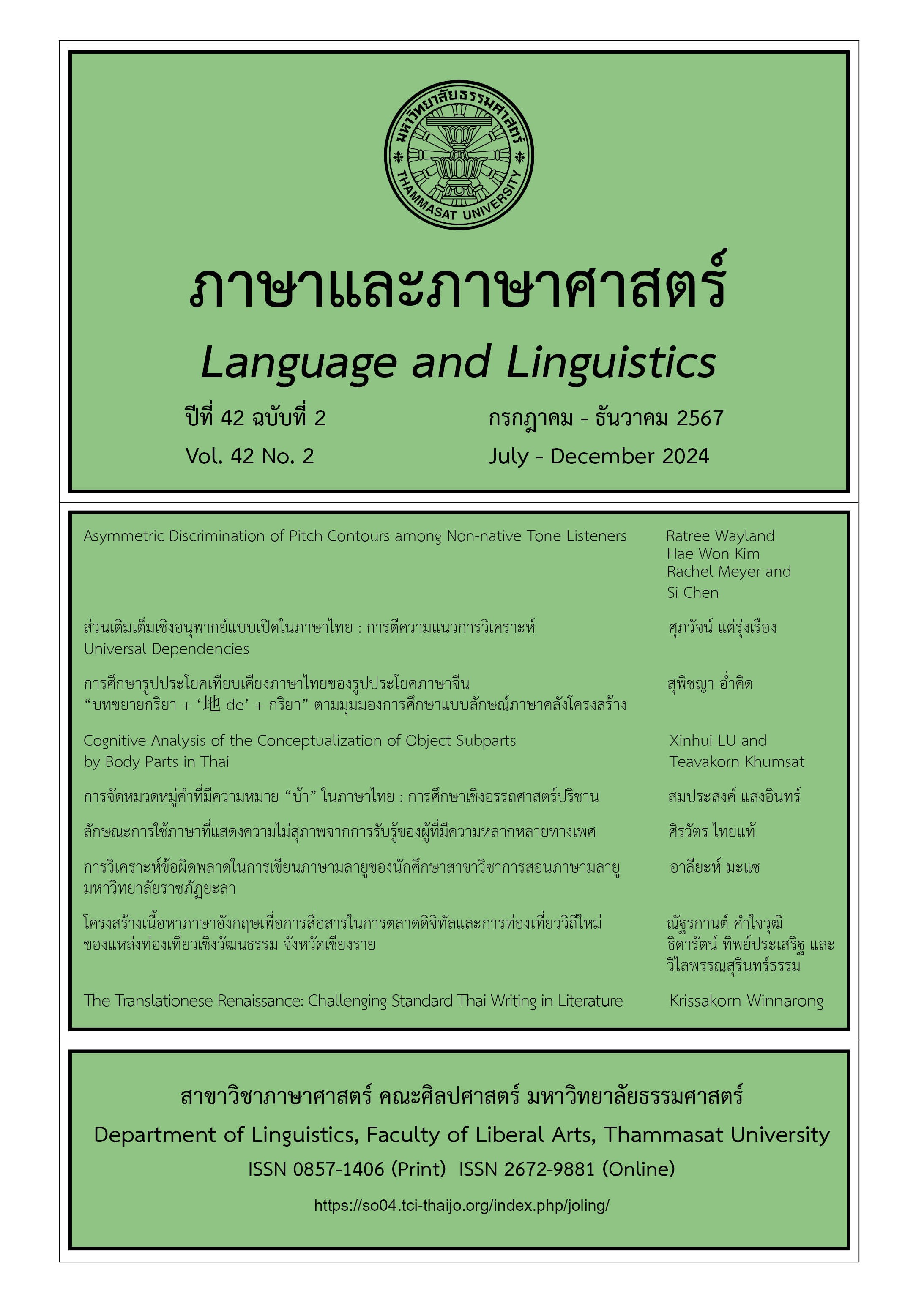Cognitive Analysis of the Conceptualization of Object Subparts by Body Parts in Thai
Main Article Content
Abstract
Thai body part terms—hua214 ‘head’, laŋ214 ‘back’, paːk21 ‘mouth’, thɔːŋ45 ‘belly’, naː41 ‘face’, tiːn33‘foot’, and kon41 ‘buttocks’—which function as free morphemes and combine with inanimate nouns, have evolved into compound word stems. These terms serve as heads of genitive constructions within compound word structures, and act as relational nouns that cause semantic expansion, enabling them to spatially locate subparts of objects such as the ‘front end,’ ‘top end,’ ‘bottom end,’ and ‘back end.’ This study utilizes the corpus from the Royal Thai Academy’s Thai Dictionary and the Thai Language Corpus to examine Levinson’s (1994) and Heine’s (1997) theories on the conceptual transfer of body parts, additionally applying Heine’s anthropomorphic and zoomorphic models, along with Lu and Park’s (2019) sleeping model, to explore how Thai body parts are cognitively conceptualized to spatially locate subparts of objects. The results indicate that the conceptualization of the front end of object subparts involves hua214, paːk21, and naː41. Specifically, hua214 is linked to the Zoomorphic Model and Sleeping Model. paːk21 is associated with the Anthropomorphic Model and Zoomorphic Model, and naː41 relies on both the Anthropomorphic Model and Zoomorphic Model. For the back end of object subparts, the conceptualization involves laŋ214 and kon41, where laŋ214 uses the Anthropomorphic Model, while kon41 uses the Zoomorphic Model. The top end of object subparts is conceptualized using laŋ214 and naː41, with laŋ214 linked to the Zoomorphic Model, and naː41 to the Sleeping Model. The bottom end of object subparts includes laŋ214, tiːn33, thɔːŋ45, and kon41, with laŋ214 using the Sleeping Model, tiːn33 using the Anthropomorphic Model, thɔːŋ45 using the Zoomorphic Model, and kon41 relying on both the Anthropomorphic Model and the Sleeping Model. This study enhances our understanding of Thai linguistics and enriches cognitive linguistics by demonstrating how Thai body part terms spatially locate subparts of objects.
Article Details

This work is licensed under a Creative Commons Attribution-NonCommercial-NoDerivatives 4.0 International License.
บทความทุกบทความเป็นลิขสิทธิ์ของภาษาและภาษาศาสตร์
References
Bybee, J., Pagliuca, W., & Dressler, W. (1985). Cross-linguistic comparison and the development of grammatical meaning Suppletion in word-formation. In J. Fisiak (Ed.), Historical Semantics - Historical Word-Formation (pp. 59-84). De Gruyter Mouton.
Bowden, J. (1992). Behind the preposition: Grammaticalisation of locatives in Oceanic languages. Australian National University.
Berendt, E. A., & Tanita, K. (2011). The ‘Heart’ of things: A conceptual metaphoric analysis of heart and related body parts in Thai, Japanese and English. Intercultural Communication Studies, 20(1), 65-77.
Heine, B., & Reh, M. (1984). Grammaticalization and reanalysis in African languages. Helmut Buske Verlag Gmbh.
Heine, B., Claudi, U., & Hünnemeyer, F. (1991a). From cognition to grammar: Evidence from African languages. John Benjamins Publishing.
Heine, B., Claudi, U., & Hünnemeyer, F. (1991b). Grammaticalization: A conceptual framework. University of Chicago Press.
Heine, B. (1997). Cognitive foundations of grammar. Oxford University Press.
Hagège, C. (2011). Adpositions: Function-marking in human languages. Oxford University Press.
Lakoff, G., & Johnson, M. (1980). The metaphorical structure of the human conceptual system. Cognitive science, 4(2), 195-208.
Levinson, S. C. (1994). Vision, shape, and linguistic description: Tzeltal body-part terminology and object description. Linguistics, 32(4-5), 791.
Lim, J. R. (2008). Exploration of Semantics in Cognitive Linguistics. Korean Literature Inc.
Lehmann, C. (2022). Foundations of body-part grammar, In R. Zariquiey & P. M. Valenzuela (Eds.), The Grammar of body-part expressions: A view from the Americas (pp. 14–76). Oxford University Press.
Lu, X. H., & Park, K. E. (2019). A cognitive linguistic study on polysemy of body part term hǔa ‘head’ in Thai. Southeast Asia Journal, 28(3), 71-122.
Lu, X. H., & Khumsat, T. (2022).The application of metonymic cognitive mechanism to construct non-body part meanings using body parts words: A case study of hua and mɯː in Thai. Chinese Journal of Social Science and Management, 6(2), 183-195.
Lu, X. H., Khumsat, T., Liu, Y., & Luttamon. H. (2024). Cognitive motivations of the construction of space-time concepts of Thai body part words nâː and lǎŋ and their prepositionalization phenomenon. Foreign Language Studies National Chengchi University, (39), 89-114.
Martinez, R., & Schmitt, N. (2012). A phrasal expressions list. Applied linguistics, 33(3), 299-320.
Perekhvalskaya, E. (2011). Body parts and their metaphoric meanings in Mwan and other South Mande languages. Human Studies, 8(1), 53-62.
Rhee, S. H. (1988). Understanding Grammaticalization. Korean Literature Inc.
Svorou, S. (1994). The grammar of space. John Benjamins Publishing.
Wang, Y. (1999). On the iconicity of linguistic signs: A challenge and supplement to Saussure’s theory of arbitrariness. Xinhua Publishing.


